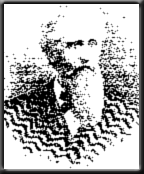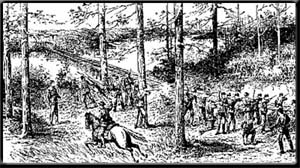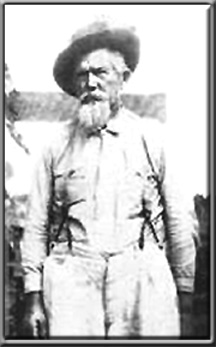

![]()
![]()
This
is probably the focal point of my FLORIDA CRACKER site, because if there was
ever a cavalry regiment who knew the true meaning of the term cracker, it
was this one. The 1st FL Special Cavalry, organized late in the war, otherwise
known as the Cow Cavalry or Cattle Guard Special Commissary Battalion,
did not brandish their swords riding Brahmans into battle- although, the sight
of that would have turned more than a few Yankees back northward!?! No, this was
a special "home guard", with a special purpose. After the fall of
Vicksburg, and the stifling of the steady supply train of cattle coming from the
Great State of Texas, the Confederacy depended on Florida to provide beef and
pork for the hungry rebel-patriots. And my ancestor, Sol Osteen, grandson
and namesake of NC Revolutionary veteran and FL pioneer, Solomon
Osteen, rode with C. J. Munnerlyn's Battalion, under E. J. Lutterloh
(pronounced Lud-loh), of the 1st Special Cavalry.

C.J. Munnerlyn
Ole Sol, God bless his dear soul, was the spitting image of
every Confederate veteran in his post-war years- white hair, long white beard.
Maybe some day, I'll get a decent picture to post. Anyone else who wants a picture
of Sol should see below, or check out The History of Levy County.
The Cow Cavalry defended the home front from marauding
deserters and Yankee forces alike. They also escorted herds of cattle to the
front and protected the often conscripted "herders" from the
"perils" they might encounter (please, consider...every willing and
able young man was already on the front line or were
guarding Florida from invasion). I'm sure they also rode shotgun on more
than one contraband caravan, seeing that Florida was able to supply quite a bit
of smuggled goods by horseback, despite their lack of rail.
Sol mentioned having fought in the battles of Ft. Farmer, Day
Landing, and Cottrell's Landing, but his most famous involvement was the Battle
of Number 4, outside of Cedar Key, led by Confederate hero, Capt. J. J.
Dickison.
Union forces had
already taken Cedar Key with the help of Union gunboats and were raiding the
countryside. Capt. Dickison, busy on the eastern coast, was alerted by Lutterloh,
of the influx of Union soldiers and their apparent plans for Lake City. Capt.
Dickison gathered all local forces and headed for the western coast, after being
granted leave and promised immediate reinforcement by train.

Battle of No. 4, Cedar
Key, FL
Sol and seventeen of his compatriots, under the leadership of
Capt. Lutterloh and the other forces that had quickly gathered outside the
Confederate outpost near Cedar Key, met Dickison on the evening of his arrival.
The next morning, early 2/16/65, knowing that over 600 white and Negro Union
troops had invaded the island of Cedar Key, the Confederate cavalry and militia
troops, numbering a third the force of the Yankees, set out for the town's
borders.
The rest of the story, I'll let Sol tell through the
recollection of a young Levy County resident, Wm. Yearty (whose father was a
veteran of Chickamauga)... "(Lutterloh's Com.) was stationed northeast
of...Chiefland, on the old Mawren Studstill farm, where the Confederates had an
iron mine and made cannon balls....That evening they reached No. 4 and had a
small skirmish under the cover of night, and the Yankees retreated back over the
railroad to Cedar Key. The next morning, the Yankees reformed and about 200
Negro troops with white officers marched back over the railroad." As it
is told, the unsuspecting troops were surprised and overwhelmed by the
forces lying in wait for them on the opposite side of the bridge, and under the
onslaught, soon broke ranks, and "ran into the black marsh grass",
where they were chased and dispatched with expediency by the vengeful Southern
cavalry. "Sol Osteen was in that battle and I have heard him describe it
on several occasions."
"War is hell", folks, or, as stated by
Sherman's antithesis, N.B. Forrest, "war means fighting, and fighting means
killing." Don't kid yourself.
Anyway, the battle raged on, and over 600 hundred Federal troops were defeated
by a force of 160 Confederate cavalry and militia. Quoting the book Dickison
and His Men, "'They fought like brave men, long and well.' They were
fighting on their own soil for their most sacred rights--many of them in sight
of their own once peaceful homes, knowing that the hearts of their loved ones
suffered the most terrible agony, as the sound of the distant cannon reached
their ear." Here endeth the lesson.
As a post-script, the Union authorities were so enraged
by the tremendous defeat, they hastily sent more troops, mostly conscripted
black soldiers, forced to serve the Union against their home states, who marched
down the coast to meet the victorious Florida forces. This rash decision led to
yet another embarrassing defeat for the Federal forces, at the Battle of Natural
Bridge.
Recently, I have discovered that Sol's father-in-law W.R. Medlin, a veteran of two Indian wars, also rode with Lutterloh's Company, Munnerlyn's Battalion, 1st FL Special Cavalry. I'll post more on his participation when I get the chance. Until then, you should really visit David Bamford and Kyle VanLandingham's site on the 1st Florida Special Cavalry (see my links page). They've got enough information there to keep you busy till I'm done, which could be a loooong time!

Solomon Osteen in his later years.
Looks like a Rebel don't he?
Sol took 3 musket balls during the war,
farmed his whole life, and
still lived to a ripe old age.
Now that's one tough Cracker.
![]()
![]()
©Ty Starkey, 1998-2003
![]()